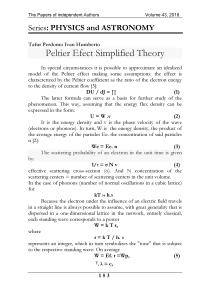Peltier Efect Simplified Theory
Автор: Tafur Perdomo Ivan Humberto
Журнал: Доклады независимых авторов @dna-izdatelstwo
Рубрика: Physics and astronomy
Статья в выпуске: 43, 2018 года.
Бесплатный доступ
Короткий адрес: https://sciup.org/148311624
IDR: 148311624
Текст статьи Peltier Efect Simplified Theory
Peltier Efect Simplified Theory
In special circumstances it is possible to approximate an idealized model of the Peltier effect making some assumptions: the effect is characterized by the Peltier coefficient as the ratio of the electron energy to the density of current flow [3]:
DU / dJ = ∏ (1)
The latter formula can serve as a basis for further study of the phenomenon. This way, assuming that the energy flux density can be expressed in the form:
U = W .v (2)
It is the energy density and v is the phase velocity of the wave (electrons or phonons). In turn, W is the energy density, the product of the average energy of the particles Ee. the concentration of said particles n [2]:
We = Ee. n (3)
The scattering probability of an electron in the unit time is given by:
1/τ = σ N v (4)
effective scattering cross-section (a). And N concentration of the scattering centers = number of scattering centers in the unit volume.
In the case of phonons (number of normal oscillations in a cubic lattice) for kT ›› h.ν
Because the electron under the influence of an electric field travels in a straight line is always possible to assume, with great generality that is dispersed in a one-dimensional lattice in the network, entirely classical, each standing wave corresponds to a power
W = k T r, where r = k T / h. ν represents an integer, which in turn symbolizes the "tone" that is subject to the respective standing wave. On average
W = Ef. r =Wp, (5)
ᵞ . λ = c,
ᵞ - it corresponds to the maximum wavelength, (minimum energy) that can be taken as a basis for the ground state,
λ = L/2 length or period of the network.
After replacing it obtains
U/J = k T Ee /e Ef (6)
In the metal, because the most likely level of electron energy is in the same valence band, can be assumed that the energy (electron) is in equilibrium with the crystal lattice
Ee. r = Wp
(average) and as
U / J = α T, α = k / e
In the own semiconductor with spherical iso-energy surfaces
Ee = h2 k2 / 2m is equal to the difference between the energy of the electrons in the conduction band and the most likely level of energy of the electrons at the given temperature [1]:
(Fermi level) = Ec-Ef.
It follows, that
U /J = k r (Ec-Ef.)/e Wp and finally
α = k/e ( Ec-Ef.)/ Ef. (7)


